New Ryzen laptops: AMD Ryzen 5000 mobile CPU specs, and performance
Ryzen 5000 Mobile shapes up to be the best CPU to pair with RTX 30-series mobile GPUs.
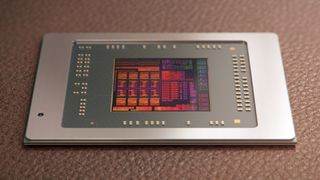
AMD talked up its new Ryzen laptops, with the shiny new Ryzen 5000 mobile processors, at CES 2021. AMD's CEO, Dr. Lisa Su, took to the virtual stage to show off a number of the new gaming laptop chips using the Zen 3 architecture (and some still using Zen 2 cores), as well as press the virtual flesh with plenty of industry big wigs (and Lewis Hamilton) because AMD is now being taken seriously, and is no longer the underdog when it comes to laptops.
The big takeaway is that Ryzen 5000 has already made the transition to the mobile space, and Ryzen laptops built around the new chips have already started appearing. Unlike previous generations, AMD is getting its Ryzen mobile CPUs into a whole lot of machines, with the likes of Asus and Acer showing off their latest gaming laptops with AMD silicon front and centre. AMD also introduced its new HX chips, which are aimed specifically at high-end gaming laptops and could be really impressive.
Nvidia announced its RTX 30-series mobile GPUs at CES too, which means plenty of new laptops that are significantly more powerful than the previous generation. With Intel also announcing its Tiger Lake H35 mobile processors, that naturally begs the question: which CPU do you want in your next laptop? AMD Ryzen 5000 mobile, last-gen Intel Comet Lake, or 11th Gen Tiger Lake H35?
AMD recently presented a deep dive on its new Ryzen laptop processors, and here's everything you need to know about all the laptop chips that AMD has on the way to hopefully answer that question.
At a glance...
AMD Ryzen 5000 mobile release date
AMD's Ryzen 5000 mobile CPUs, codenamed Cezanne, are already appearing in some Ryzen laptops and the whole range should be appearing through February and into March. There may be a few outliers, but if you're in the market for a new AMD Ryzen laptop, you shouldn't have to wait long.
AMD Ryzen 5000 mobile specs
The majority of the Ryzen 5000-series mobile lineup use AMD's new Zen 3 architecture, although there are three Zen 2 chips in there too, just to confuse things. You're going to need to pay attention to model numbers to check what you're buying.
AMD Ryzen 5000 mobile performance
Zen 3 represents a healthy speed boost over Zen 2, and thanks to power efficiency improvements, things look even better on mobile. AMD is quoting a 23 percent single-core performance improvement over last gen. Impressive.
The biggest gaming news, reviews and hardware deals
Keep up to date with the most important stories and the best deals, as picked by the PC Gamer team.
AMD Ryzen 5000 mobile pricing
AMD upped the pricing of its Ryzen chips by $50 on desktop, and we'd expect similar increases for its mobile chips, although laptop pricing is an entirely different beast. You can probably expect to spend a bit more to get the fastest chips around.
Release date
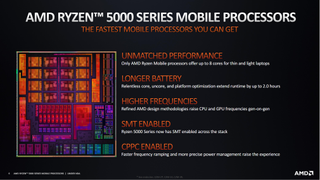
AMD Ryzen 5000 mobile release date
AMD Ryzen 5000 laptop chips are already starting to trickle out, with a few early samples making their way to reviewers. You can expect the main slew of machines to start appearing in stores from the beginning of February through to March.
Laptops from the likes of Asus, Acer, Gigabyte, HP, Lenovo, MSI, and more should be available imminently, although specific models may take a little while to appear.
AMD says it has chips in over 150 Ryzen laptops now, although not all of those will be available right away. It's going to be pay to work out which particular laptop you want, and then see when it's available.
The fact that these new Ryzen 5000 CPUs are pin-compatible with the previous Ryzen 4000-series chips means that OEMs have been able to drop them in existing chassis without necessitating a redesign. As there are some powerful chips in AMD's arsenal, it could be that we see specific laptops appear through the year that really push what Ryzen 5000 Mobile is capable of.
One issue that may affect the availability of the next-gen laptops is chip supply. AMD has seen incredible demand for its desktop processors, with the chips selling out before the start of 2021, and some retailers still struggling to get stock.
These new mobile CPUs rely on the same TSMC 7nm node used for the Zen 3 desktop chips and AMD's GPUs as well, so this basically equates to even more demand for TSMC production.
The best gaming laptops are also going to want to use Nvidia's mobile GPUs, and Nvidia has its own supply problems as well, meaning that there are two constrained supply chains that could see less laptop stock than normal.
You can expect shortages for the most popular Ryzen laptops.
CPU Specs
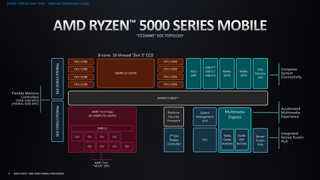
AMD Ryzen 5000 mobile specs
AMD was taping out the Zen 3 mobile CPUs just three months after getting Zen 2 mobile chips into machines. That's important, not only because it's one of the fastest turnarounds for a new generation of processors, but also because AMD had Ryzen 5000 mobile in mind when it was putting forward Ryzen 4000. The idea from the start was that the new chips would be pin-compatible with existing offerings.
The upshot of this is that laptop manufacturers can take the new CPUs and drop them into existing designs. And with laptop designs generally on a yearly cadence, that was an essential decision to deliver genuine momentum, and a decent number of design wins for the red team.
So while Ryzen 5000 mobile CPUs do use the new Zen 3 architecture (at least most of them do), the rest of the package is pretty much the same, with a few tweaks to support LPDDR4 and efficiency improvements as well. But you're looking at the same Vega graphics cores, the same PCIe 3.0 support, USB, etc.
Zen 3 represents a significant upgrade to the previous generation, with a huge performance improvement thanks to its shift from a pair of quad-core chiplets to an eight-core layout instead. All eight cores share a large 16MB of L3 cache, which is double that of the previous generation.
The new chips also get a new memory controller, which brings with it support for LPDDR4x and lower power states to help improve efficiency. LPDDR4x can run at 4,266MT/s, which is 33 percent faster than DDR4 at 3200MT/s, and it has twice the density of DDR4 too, so you're looking at up to 32GB with a dual-channel setup.
The fact that Ryzen 5000 mobile is still sporting Vega GPUs is a little disappointing, but AMD has tweaked the power management to improve efficiency. You get up to eight compute units in its mobile form, with 1MB of L2 cache and a peak frequency of 2.1GHz.
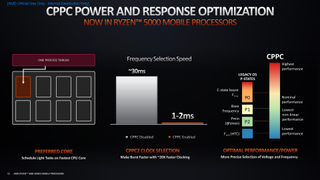
One technology that was introduced with Ryzen 3000 desktop chips that still pulls a lot of weight in mobile form is AMD's Collaborative Power Performance Control (or CPPC for short). On desktop its important for telling Windows which cores are the fastest so that the Windows scheduler can prioritize them.
On mobile, CPPC has the added benefit of offering far more granular power management, so that OS can dictate the voltage and frequencies of the individual cores in a range of values on the fly. This is obviously great for efficiency, but it also means that overall performance can improve, as unneeded cores are powered down for the benefit of others.
| Model | Cores / Threads | Max Boost | Cache | GPU Cores (Max Boost) | TDP |
| Ryzen 9 5980HX | 8 / 16 | 4.8 (3.3) | 20MB | 8 (2.1 GHz) | 45W+ |
| Ryzen 9 5980HS | 8 / 16 | 4.8 (3.0) | 20MB | 8 (2.1 GHz) | 35W |
| Ryzen 9 5900HX | 8 / 16 | 4.6 (3.3) | 20MB | 8 (2.1 GHz) | 45W+ |
| Ryzen 9 5900HS | 8 / 16 | 4.6 (3.0) | 20MB | 8 (2.1 GHz) | 35W |
| Ryzen 7 5800H | 8 / 16 | 4.4 (3.2) | 20MB | 8 (2.0 GHz) | 45W |
| Ryzen 7 5800HS | 8 / 16 | 4.4 (2.8) | 20MB | 8 (2.0 GHz) | 35W |
| Ryzen 5 5600H | 6 / 12 | 4.2 (3.3) | 19MB | 7 (1.8 GHz) | 45W |
| Ryzen 5 5600HS | 6 / 12 | 4.2 (3.0) | 19MB | 7 (1.8 GHz) | 35W |
| Ryzen 7 5800U | 8 / 16 | 4.4 (1.9) | 20MB | 8 (2.0 GHz) | 15W |
| Ryzen 7 5700U | 8 / 16 | 4.3 (1.8) | 12MB | 8 (1.9 GHz) | 15W |
| Ryzen 5 5600U | 6 / 12 | 4.2 (2.3) | 19MB | 7 (1.8 GHz) | 15W |
| Ryzen 5 5500U | 6 / 12 | 4.0 (2.1) | 11MB | 7 (1.8 GHz) | 15W |
| Ryzen 3 5400U | 4 / 8 | 4.0 (2.6) | 10MB | 6 (1.6 GHz) | 15W |
| Ryzen 3 5300U | 4 / 8 | 3.8 (2.6) | 6MB | 6 (1.5 GHz) | 15W |
AMD has split the new chips into three categories: HX at the very high with a 45W+ TDP and supporting overclocking, HS for high-performance chips with a TDP of 35W, and the U chips (which include three Zen 2 designs) for ultraportables with their 15W TDP. The Zen 2 chips are the Ryzen 7 5700U, Ryzen 5 5500U, and the Ryzen 3 5300U, the rest all feature the new Zen 3 cores.
Performance
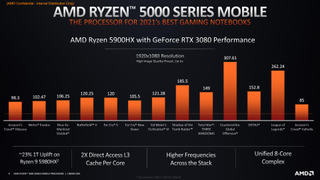
AMD Ryzen 5000 mobile performance
In terms of straight CPU performance, things are looking pretty good for AMD's new Ryzen 5000 mobile chips. The fact the new CPUs are pin-compatible with the previous generation means it can swap out a last-gen chip for a new one and compare and contrast.
AMD is seeing a 23 percent improvement in single-core performance over the last generation. That's thanks to the improvements made moving over to Zen 3, plus additional savings from power efficiency improvements and moving over to support LPDDR4, which offers up more bandwidth than straight DDR4. That's a decent boost over the 19 percent improvement simply from going from Zen 2 to Zen 3.
As with the desktop Ryzen 5000s, one of the big improvements offered by Zen 3 is the shift to using a monolithic eight-core design around a large 16MB shared cache. In Zen 2 the same 8-core chip was constructed from a pair of quad-core chiplets, each sharing 4MB of cache. This change in layout and doubling of the cache makes for a more efficient core.
Ryzen 5000 Mobile is essentially the same as Ryzen 4000 outside of the upgrade to Zen 3, with the same Vega cores and PCIe 3.0 buses, but the improved efficiency in the core means that the graphics subsystem operates 350MHz faster, if you find yourself using the integrated graphics that is.
Battery life is also getting a boost from this latest reworking, with AMD claiming up to 20 hours of extra standby time, nearly four hours of idle time, an extra hour of video playback and up to two hours in MobileMark 2018. Battery life is better is the take away from this, which isn't to be sniffed at when overall performance is also improved.
Assessing the overall impact the CPU has on a laptop is not so straightforward. There are very few laptop models out there that represent an even playing field between AMD and Intel. Chipset, cooling, battery life, and plenty of specific engineering tricks that ensure the processor works optimally make for muddy waters when trying to ascertain whether an AMD or Intel chip is the best option to buddy up with a cutting-edge GPU.
As AMD's market share improves this situation will likely get better and as we head into 2021 there may be a fair few models that make for easier comparisons between the two chipmakers. In the meantime, we're left with both Intel and AMD saying that they have the best processors for gaming laptops.
AMD does have a few slides showing off just how good its top Ryzen 9 5900HX pairs with Nvidia's RTX 3080. And while this top-end chip only has a PCIe 3.0 x8 interface to that beastly GPU, it still produces the kind of framerates you'd be happy with on a desktop.
Pricing
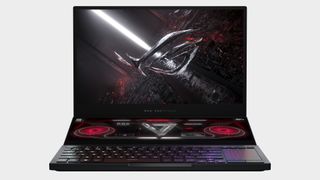
AMD Ryzen 5000 mobile pricing
The performance improvement that AMD introduced with Zen 3 was also accompanied by a $50 increase in the ticket price. It also saw the CPU cooler left out of the box in the top-end chips, but our therapist says we've got to let that go. It's time to move on. The point being, AMD has cottoned on to the fact that its new chips are leading the pack, and as such, it can charge more for them.
It only makes sense then that it will try and squeeze more out of its newer, faster mobile CPUs. Things are a little more complex when it comes to laptops though. Firstly, AMD doesn't get to charge the end-user directly, and so has to negotiate pricing with the laptop builders.
More importantly, though, AMD is still making inroads on laptops, and as such needs to not just be competitive with Intel in terms of performance, but it needs to offer great value for money as well. At least in the short term. It needs to increase its market share more than chase every nickel and dime.
There's no point AMD having the performance lead if its chips are too expensive.
An important element here is that laptops tend to be sold at specific price points, or price bands. And yes, this applies to gaming laptops as well. Nvidia is renewing its push to have decent gaming machines hitting the $999 mark with its RTX 3060 mobile GPUs, and if AMD wants a piece of that action, it needs a competitive gaming CPU that fits within that budget.
This is the reason that there are three Zen 2 chips in AMD's Ryzen 5000 mobile line up. It gives laptop builders some options at the more affordable end of the market. The only problem here is that Zen 3 is such an improvement over the previous generation, that we couldn't all good conscious recommend buying one of the Zen 2 options—so, avoid the Ryzen 7 5700U, Ryzen 5 5500U, and Ryzen 3 5300U unless the price is just too good to ignore.
We would expect there to be a premium for AMD's Ryzen 5000 mobile chips at the top end, particularly around the 5900HX and the 5980HX, which are unquestionably enthusiast-class models. The fact that such processors need proprietary cooling solutions to really strut their stuff implies that this is the kind of silicon you'll see in $2,000+ system alongside Nvidia RTX 3080 mobile GPUs.
Alan has been writing about PC tech since before 3D graphics cards existed, and still vividly recalls having to fight with MS-DOS just to get games to load. He fondly remembers the killer combo of a Matrox Millenium and 3dfx Voodoo, and seeing Lara Croft in 3D for the first time. He's very glad hardware has advanced as much as it has though, and is particularly happy when putting the latest M.2 NVMe SSDs, AMD processors, and laptops through their paces. He has a long-lasting Magic: The Gathering obsession but limits this to MTG Arena these days.
Most Popular

